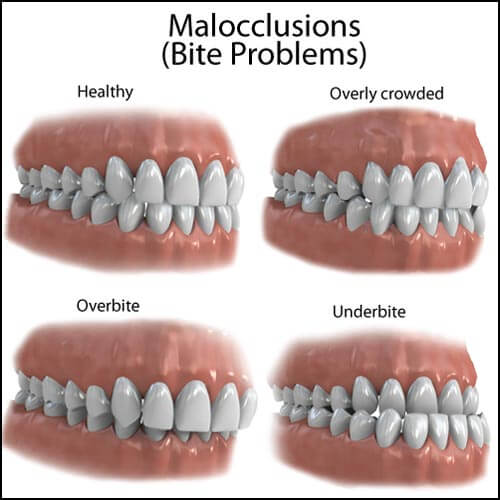A malocclusion, meaning a “poor bite,” refers to several different types of conditions of the teeth. Many people want to know the malocclusion definition and what are the malocclusion classes.
Malocclusion is an umbrella term that encapsulates a number of different afflictions of the teeth and jaw, and in this article, we will differentiate between the malocclusion classes in order to give a better understanding of each malocclusion class. From there, we will also take a closer look at a few real-life examples of different types of malocclusions to further the understanding of what that really means.
What is the Difference Between an Occlusion and a Malocclusion?
An occlusion can be defined as the contact between teeth. A malocclusion means that the contact between teeth is not ideal. A “normal fit” is displayed as the upper teeth being slightly forward over the lower teeth. A malocclusion is defined by how exactly those upper and lower teeth fit together if they don’t sit within a normal fit.
Classifications of Malocclusion
The classification of malocclusion comprises three malocclusion classes. Read on to see what they look like in the mouth, as well as a quick explanation of what a normal fit consists of.
The Three Malocclusion Classes
- Class 1 malocclusion. Even if the upper and lower teeth are sitting where they need to be, the teeth themselves are crowded, or conversely have too much space between them. Cross bites, rotations and overlapping are common characteristics of a Class 1 malocclusion.
- Class 2 malocclusion. The lower teeth fit the upper teeth. The problem here is that they sit toward the throat which pulls back the chin.
- Class 3 malocclusion. The lower teeth are too far forward and do not fit with the upper teeth at all. This can cause the jutting of the jaw and lower front teeth which become a cross bite with the upper section of teeth.
Types of Malocclusions
Now that we have become familiar with the malocclusion classes, let us take a look at some of the real life examples that get classified.
- Upper protrusion, or overjet. In an upper protrusion, the front teeth on the upper jaw are pushed forward into the “buck teeth.” A lower jaw that is too small may be a cause. The use of a pacifier during infancy or thumb-sucking can also lead to an upper protrusion as it pushes the teeth out, and can sometimes even cause the upper palate to change shape entirely.
- Crowding or spacing problems. Having either too much room for the teeth or not nearly enough causes spacing and crowding problems. The issue here is that the crowding of teeth can prevent permanent teeth from coming in the proper way. Crowding can also lead to impaction, or the teeth not coming in whatsoever.
- Misplaced midline. In those who possess a misplaced midline, the line in the front and center of the upper front teeth do not line up with the center line in the lower front teeth.
- Open bite. The teeth may fit together as normal with an open bite. However, the lower and upper front teeth do not overlap at all. This means that there is an opening that goes straight into the mouth. This applies to the front upper and lower teeth, to one or both sides of the mouth.
- Overbite. Someone who has an excessive overbite will notice that the front upper teeth overlap the lower teeth far too much. In some severe cases, this can have the lower teeth biting into the roof of the mouth uncomfortably.
- Underbite. With an underbite, the lower front teeth are going to be further forward than the front upper teeth.
- Cross bite. Some or all of the upper front teeth fit into the wrong side of the lower ones.
- Rotation. Rotation simply means that a tooth has turned out of its usual position.
- Transposition. When teeth grow, or erupt, in the place of another tooth, this is transposition.
A malocclusion is where the teeth do not rest against each other in a normal way. When the teeth have a regular occlusion, this is called a normal fit. It means that the upper teeth are just slightly more forward than the lower ones. A malocclusion, however, can stand for many ways that the teeth sit in relation to each other in positions that they are not normal, which can be damaging.
Conclusion
Do you have any sort of malocclusion that you recognize from these descriptions? Are you curious if you might have one of these malocclusions? Do you have further questions about the malocclusion definition or the various malocclusion classes? What do you think about these positions of the teeth in general? Leave a note in the comments section!


Leave a Comment